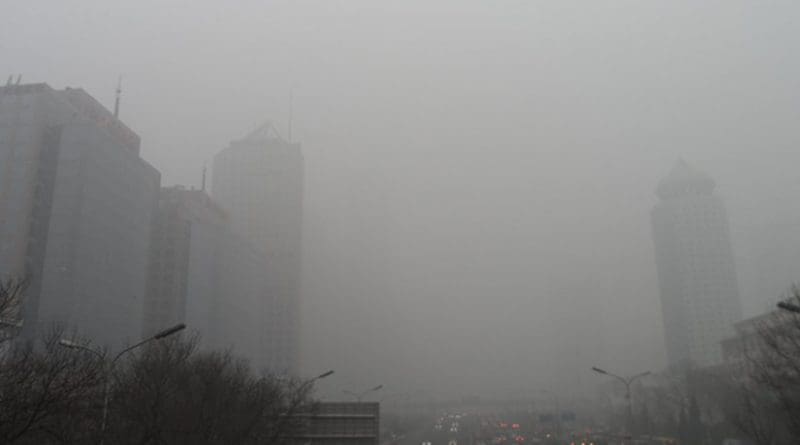World Leaders Aim To Lift Gloom In Climate Change Fight – OpEd
By Arab News
By Andrew Hammond*
French President Emmanuel Macron will next week co-host the “One Planet” summit at the UN in New York. The landmark event, which will see both government and private sector leaders in attendance, is intended to offer a jolt of optimism at a time when there is growing pessimism about the battle to tackle climate change.
There is not just the ongoing tragedy of increased deforestation in the Amazon. In addition, more and more data is alarming climate scientists such as Sir David King, who asserted on Monday that extreme events linked to global warming are occurring sooner than forecast and that the resulting weather phenomenon are “scary.”
The One Planet summit — which is also co-hosted by UN Secretary-General Antonio Guterres, former World Bank Group President Jim Yong Kim, and UN Special Envoy for Climate Action Michael Bloomberg — comes not long before the fourth anniversary of the landmark agreement struck at the 2015 Paris climate change summit. Much attention since then has focused on the backlash against Paris by populist leaders like US President Donald Trump and Brazilian President Jair Bolsonaro. They are clearly fighting a rearguard action, albeit one that has the potential to significantly hold back efforts to tackle global warming.
One manifestation of the reality of changing attitudes about climate change is the growth of domestic climate legislation and regulation adopted by nations, as regular studies published by the Grantham Research Institute at the London School of Economics and Political Science reveal. Seen as part of the big picture of the period since the Kyoto Protocol was agreed in 1997, the number of global warming laws and policies in the approximately 100 countries under review by the Grantham Research Institute has grown from 54 to more than 800; and there are also very important climate measures in place in key sub-national areas, including cities.
One of the consequences of this is the growing possibility of what may
ultimately become a truly global carbon-trading market — a potentially
game-changing economic and political development, in which Asia-Pacific
is leading the charge. Already, more than three dozen countries and more
than 20 cities, states and provinces across the world use
carbon-pricing mechanisms or are planning to do so.
While much attention inevitably focuses on the 28-country EU scheme —
currently the largest in the world — there is fast-paced action right
across the world. In Asia-Pacific, for instance, the Paris deal was
signed into law as early as 2016 by multiple key countries, including
Australia, Bangladesh, China, India, Indonesia, Japan, Kazakhstan,
Malaysia, New Zealand, South Korea, Singapore, Sri Lanka, Thailand, and
Vietnam.
The fact that Asia-Pacific is helping lead the way in this area is
underlined by China’s planned national emissions trading system, which
will probably eventually surpass the size of the EU’s. However, China is
far from alone in moving in this direction in Asia-Pacific. For
instance, Kazakhstan introduced a carbon-trading scheme in 2012,
becoming the first Asian country to do so, while Vietnam and South Korea
also have similar schemes.
And this all comes in the context of China’s own moves toward a
carbon-trading scheme. In 2014, Beijing embraced a “National Plan for
Tackling Climate Change,” which includes a target to, by 2020, cut
carbon emissions per unit of gross domestic product by between 40 and 45
percent from 2005 levels.
As these examples underline, at the heart of these promising
developments is growing belief that carbon trading is the most
economically efficient way to meet the political ambition of reducing
emissions of greenhouse gases. Along with other countries in the region,
this represents what could become an Asia-Pacific carbon-trading hub in
the battle against global warming.
Going forward, this system may, in turn, be linked with the EU scheme,
which has been widely studied by international policymakers, including
in Beijing, as they consider the design of their own programs. With a
view to maintaining its lead on the climate change agenda, the EU system
is currently being reformed to help reduce greenhouse gas emissions by
at least 40 percent by 2030.
By linking Europe and Asia-Pacific in this way, this potentially game-changing economic and political development of a nascent global carbon-trading hub is also being driven elsewhere, and it is possible to envisage a wider scheme involving the Americas and other regions too. This includes the Middle East, where the Paris deal was signed into law as early as 2016 by key countries including the UAE and Saudi Arabia.
Countries in the Americas that have ratified Paris include Argentina,
Canada, Mexico, Peru, and Uruguay, while the US and Brazil also ratified
before Trump and Bolsonaro took power and sought to roll those
commitments back. A global carbon hub linking continents from Europe to
Asia-Pacific with the Americas could include state-level schemes in the
US, such as in California, and the Regional Greenhouse Gas Initiative in
Northeastern US states, plus the scheme in Quebec and potentially other
future Canadian initiatives.
Taken overall, at a time of pessimism in the climate change debate, the
Paris deal has bolstered prospects of a global carbon market emerging.
This has the potential to become a game-changing development in the
fight against global warming.
- Andrew Hammond is an Associate at LSE IDEAS at the London School of Economics

